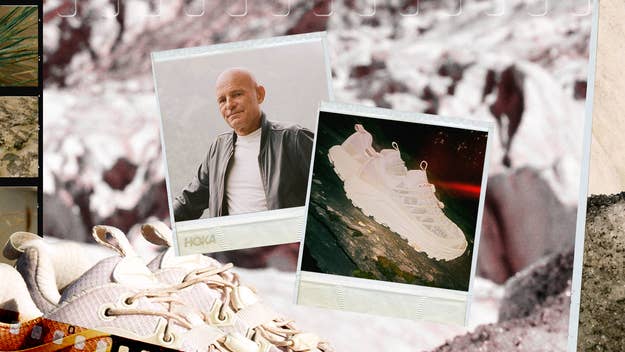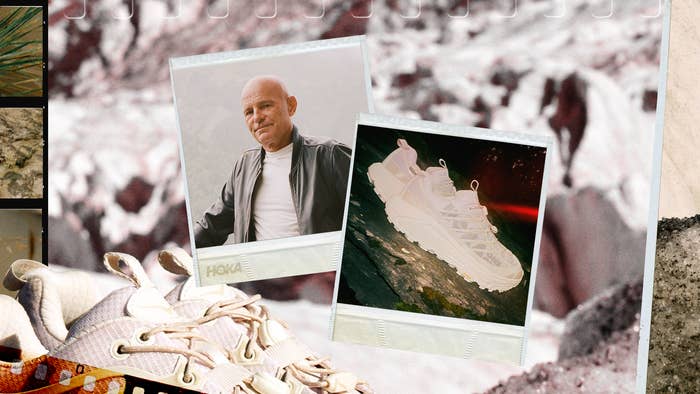
Innovation is often born out of necessity, and in 2008, shoe connoisseurs and running aficionados Nico Mermoud and Jean-Luc Diard were in need of a shoe that made downhill running faster, without compromising comfort. So, ready to hit running trails and train with ease, the duo created HOKA, a dynamic and advanced running shoe brand.
Initially built for trail runners, HOKA has become a go-to shoe for marathoners, casual runners, and more. And that effervescent interest is why HOKA looms so largely amongst athletes. But in a world where sneaker tastes have evolved to embrace more brands and daring silhouettes, HOKA has found another place to fly, which is on the feet of those who wish to mix their fashion preferences in with their fitness routines.
At its heart, HOKA is about comfort and performance: two leading principles that show just how far the marriage between practicality and eye-catching beauty can go. Travis Wiseman, HOKA’s director of lifestyle product as of 2022, has led the brand through collabs with notable names in luxury fashion, streetwear, and design—to dazzling results.
The Mafate prototype was developed in 2009, and HOKA just launched the latest reworking of a brand original, the Mafate Three2. The shoe is named for its blend of the Mafate Speed 2 and Mafate 3, and built to satisfy brand loyalists while reeling in the next generation of HOKA wearers.
In anticipation of the new Mafate Three2, Complex recently sat down with Mermoud and Wiseman to learn the importance of the HOKA legacy, how the brand has trended with the times, and their shared love for creativity.

Nico Mermoud, Co-Founder
HOKA’s Origins
We tried to solve gravity, [to] have people use a piece of technology which would help them navigate through downhill trails. Not as hikers and even traditional runners, but almost like if they were surfing, cycling, or skiing. So we imagine[d] a midsole, which is very soft, which is oversized. And which would give you not only cushioning, but stability, filtration of the shocks, and also energy return when you run down the trails.
[But when] I moved to America, I got a lot of comments from runners and shop owners who said, "This is very nice; it's very innovative. The feel is unbelievable, but it shouldn't be limited to trail and downhill." It's been a crazy journey to go from these prototypes designed here in the Alps, to embracing the road market [and] the triathlon market.
What Inspired HOKA’s First Shoe
Mafate is the one. It's the mother and father of all of the HOKA shoes. It refers to Zürich and the Réunion islands, where I ran and raced in 2008. For me, it's one of the most beautiful spots in the world. It's 7,000-feet deep and it's a lot of extinct volcanoes. We were trying to imagine a shoe [that] would do extremely well on all of these terrains, [including] lava, dirt, rocks, trails, everything. That's where we did some of the first testing in 2009. That's where we had our first big podium in ultra running. The shoe is absolutely legendary there.
HOKA’s Appeal
I know the consumers, and especially a lot of the people who are fans of your magazine, they want to know a lot about the products, the history, [and] all of the roots. And I think what's really special about the HOKA product is beyond the lifestyle—it works. It's proven technology. I hope the people who discover the product, who discover the lifestyle that's behind it and the brand, I hope it makes them want to one day…travel to use the products on site because it's an unbelievable experience.
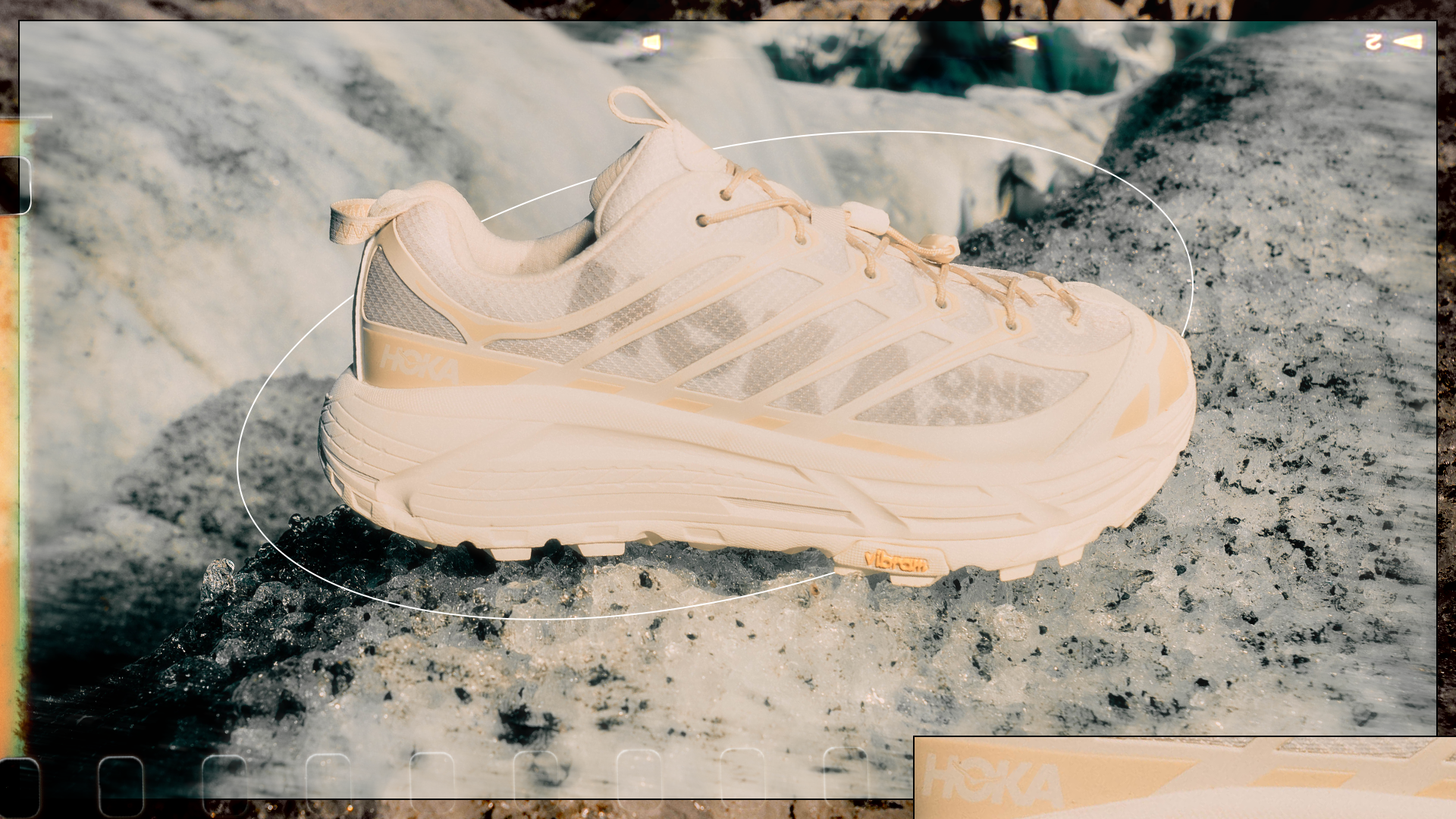
Making Running Feel Like Flying
Our brand mission, since day one, remains to [be] to make as many humans as possible fly and to grow the circle, to grow as a team, to grow as a family. What does it mean if we want to make more humans fly? When they run, spend more time in the air, less time on the ground, that's what every runner is trying to achieve. More air time, less ground time. From a biomechanical and physical standpoint, [that’s] a smoother landing, and a quicker and more dynamic takeoff. And that's in your body, that's in your feet. The day you fly is the day everything is falling in place, and where you feel extremely relaxed and smooth. And we want that.
Translating Joy Through shoes
We want people to enjoy a lifestyle where you escape, where you have freedom, where you have the adrenaline, where you can go faster. And [where they] can share that also with friends [and] with the community. That's where I think the technology joins the lifestyle. You fly in your head no matter what, no matter where you are. What's super exciting about HOKA in 2023 is that most of the shoes scream happiness and joy of running.
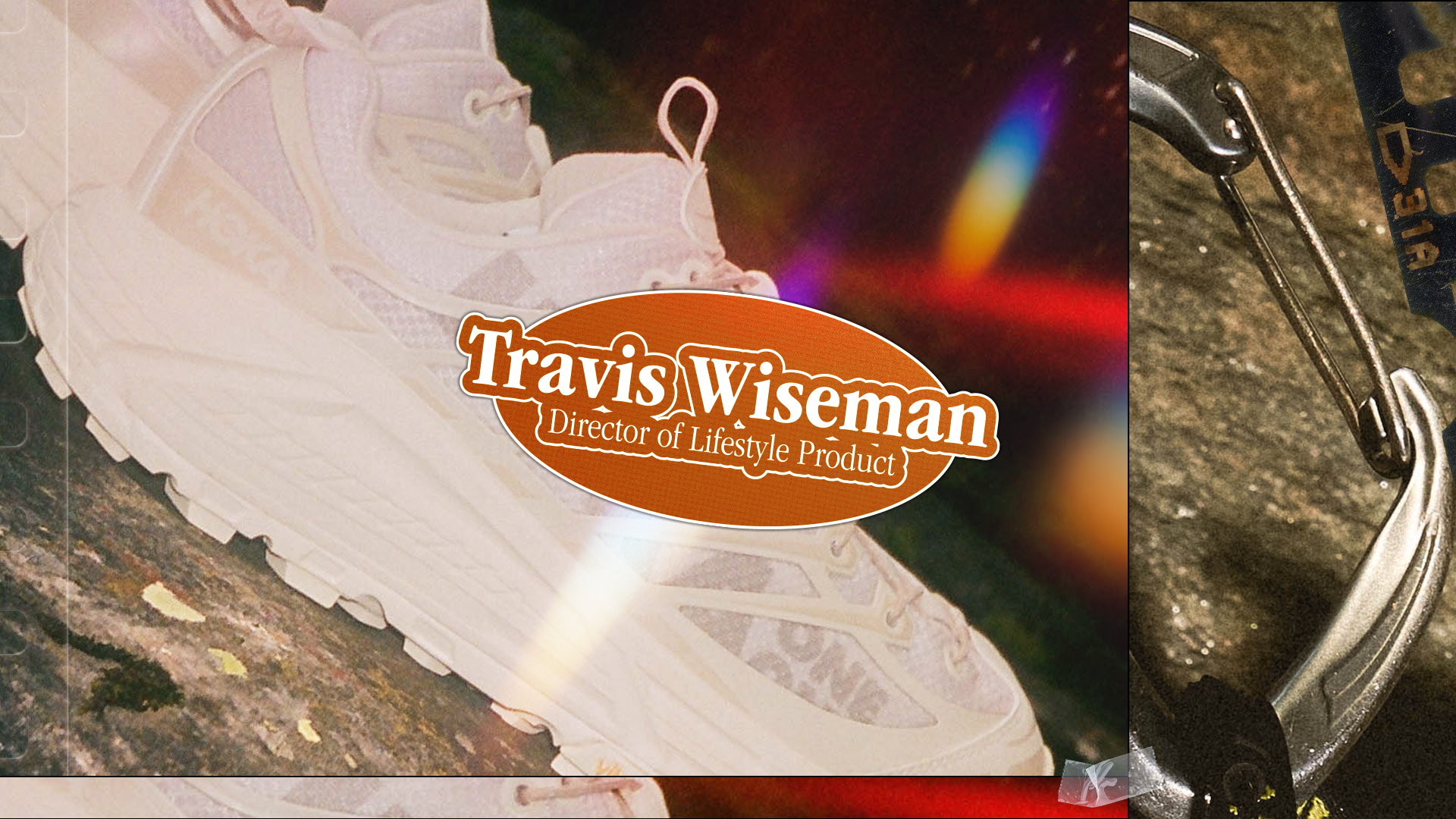
Travis Wiseman, Director of Lifestyle Product
Choosing HOKA
I joined HOKA [around] the beginning of 2022. I was at the point in my career [where] I wanted to try something new. From day one, my job has been trying to build a strategy that's sustainable around lifestyle. [It’s been] staying true to all the origins and the things that Nico and the team have based this brand on, but just finding a new way to re-contextualize it through the lens of lifestyle and really getting after a younger, more trend-relevant consumer.
Designing the Mafate Three2
Nico and the team are known for tinkering and shaving down foam, smashing things together, gluing things to create new concepts and shapes. That was the same process [for] making the Mafate Three2. We knew we wanted to do something that was kind of a mashup, but it took a lot of exploration to [find] the right combination of different bottom units versus which uppers we could use to re-contextualize the product for today.
The Mafate Three2’s Most Distinct Factor
We could [maybe believe] that every HOKA shoe starts with the bottom unit. It's the stack height that provides that cushioning. The meta rocker that really makes you glide into your steps. And aesthetically, the chunky shoe is definitely having a moment. So just by genesis of doing what we've been doing, this product has been something that's been able to be adapted from a trend point of view.
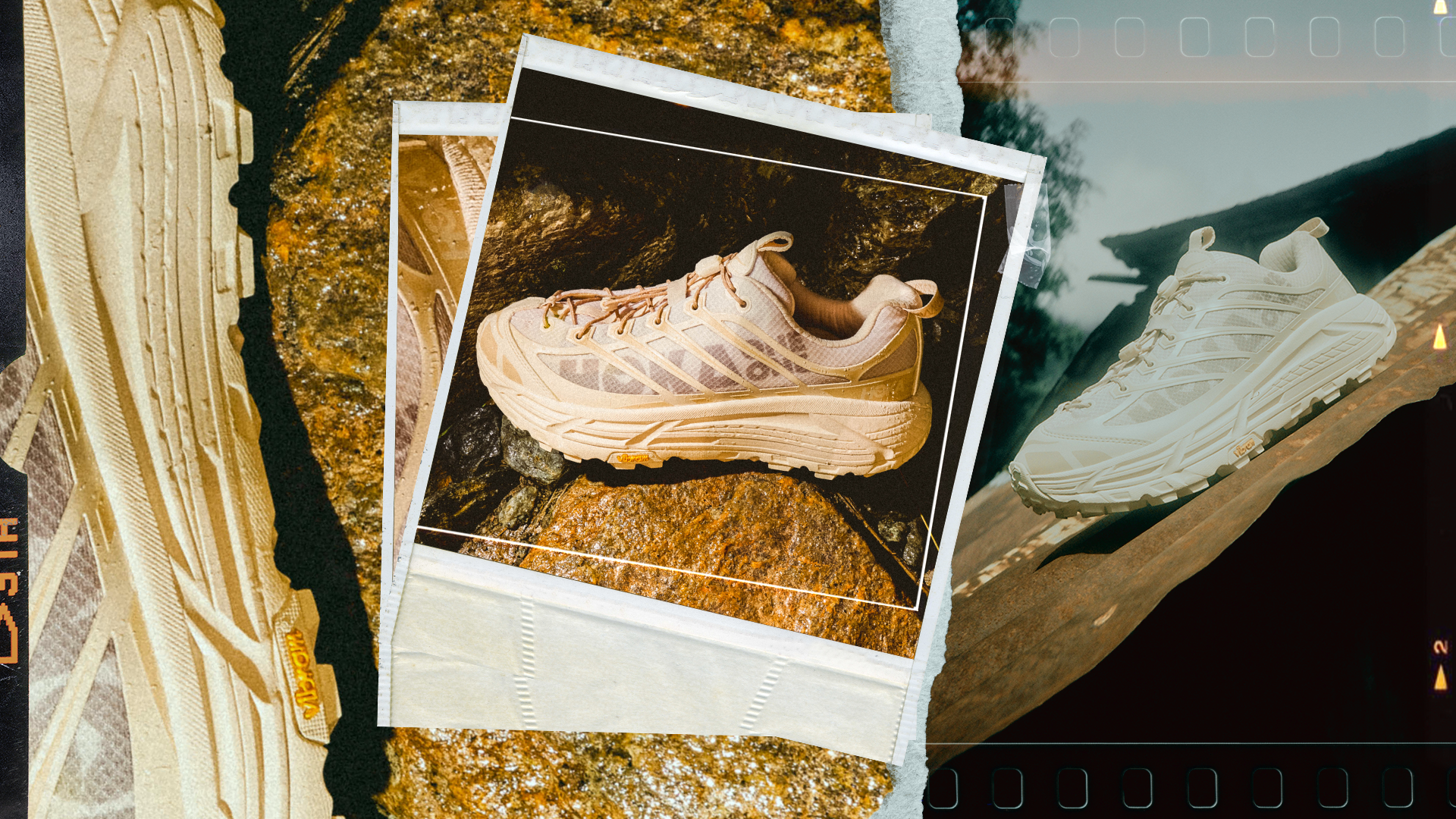
Making Fashion Work With Function
We really try to blur the lines of function and style. Everything that we do is going to be rooted in functionality—that's just what the brand is known for. But how we're able to utilize colors and materials, that's where we want to push it into more of a style context. If you look at the color flows, how they drop, you see the full gamut from things that are more toned down and muted, and things that are more toned up. Definitely more of a nod back to the heritage.
Being Motivated by HOKA’s Past
Everything we do, it's based on where has the brand been. That really informs where we go. So I would also give the kudos back to Nico just for creating very dope, compelling stuff from the very beginning. That drives and fuels us, and definitely gives us the space to explore and tinker. I think that mentality of just getting your hands dirty [and] trying different things, that's definitely something that we prescribe to as a product team. Just really seeing what all the possibilities are while still being very much true and authentic to where the brand will come from.
What Shoes Can Represent
Footwear is a form of self-expression. It's just a window into what your interests are, what you like. If [someone is] into retros and certain more of the sneaker things, you kind of have a good perspective of the ecosystem that is around sneaker culture and what they could be into potentially, from a music, and sports, and fashion point of view. [They’re] like a window to people's personalities.

Choosing Brand Collaborations
Brands like Bodega and Brain Dead, we partner with those people because there's an organic connection. From a product standpoint, I think it's really big as the category grows that we continue to show the brand in a different light. Both the Hopara from Brain Dead and the Tors from Bodega very much stayed true to the original silhouettes, but we found different materials and colors to lean both of those projects into the streetwear space. Many consumers are aware of us as a running brand, as a trail brand, but we're also a lifestyle brand. You'll see from us, throughout the finish [of] the year, some additional really cool collaborations.
The Best Parts of HOKA
It's been really cool just to see not only the evolution of lifestyle, but just also the continued focus in performance. We just had UTMB, which is the biggest trail running event in the world, a couple of weeks ago. And the winner of the [men’s race was] a HOKA athlete [Jim Walmsley]. So just to see the different categories, and how they're showing up and how everybody is kind of on the same path. There's always this red thread that, as we continue to push and innovate from a performance standpoint, also feeds into lifestyle. I think it's really cool to be part of the ecosystem where every part of the brand feeds off each other.
What Draws Consumers to HOKA
I think growing up in sneakers, you definitely saw direction led by a couple of brands, which was cool. But I think now, just to see so many different brands and so many different options, it really makes way for brands like us. I think the consumer's open to trying some new things and looking for something new and something fresh. And I think that's been part of the reason why we've seen some success: The consumer's probably more open-minded now than ever.

